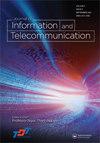Can EEG-devices differentiate attention values between incorrect and correct solutions for problem-solving tasks?
IF 1.7
Q2 COMPUTER SCIENCE, INFORMATION SYSTEMS
Journal of Information and Telecommunication
Pub Date : 2021-08-04
DOI:10.1080/24751839.2021.1950319
引用次数: 4
Abstract
ABSTRACT The affective state of an individual can be determined using physiological parameters; an important metric that can then be extracted is attention. Looking more closely at compact EEGs, algorithms have been implemented in such devices that can measure the attention and other affective states of the user. No information about these algorithms is available; are these feature classification algorithms accurate? An experiment was conducted with 23 subjects who utilized a pedagogical agent to learn the syntax of the programming language Java while having their attention measured by the NeuroSky MindWave Mobile 2. Using a concurrent validity approach, the attention values measured were compared to band powers, as well as measures of task performance. The results of the experiment were in part successful and supportive of the claim that the EEG device’s attention algorithm does in fact represent a user’s attention accurately. The results of the analysis based on raw data captured from the device were consistent with previous literature. Inconclusive results were obtained relating to task performance and attention.脑电图设备能否区分解决问题的正确解决方案和错误解决方案之间的注意力值?
摘要个体的情感状态可以通过生理参数来确定;然后可以提取的一个重要度量是注意力。仔细观察紧凑型脑电图,算法已经在这种设备中实现,可以测量用户的注意力和其他情感状态。没有关于这些算法的信息;这些特征分类算法准确吗?对23名受试者进行了一项实验,他们使用教学代理学习编程语言Java的语法,同时通过NeuroSky MindWave Mobile 2测量他们的注意力。使用并发有效性方法,将测量的注意力值与带功率以及任务表现的测量值进行比较。实验结果在一定程度上是成功的,并支持了脑电图设备的注意力算法实际上准确地代表了用户的注意力的说法。基于从该设备获取的原始数据的分析结果与以前的文献一致。在任务表现和注意力方面获得了不明确的结果。
本文章由计算机程序翻译,如有差异,请以英文原文为准。
求助全文
约1分钟内获得全文
求助全文
来源期刊
CiteScore
7.50
自引率
0.00%
发文量
18
审稿时长
27 weeks

 求助内容:
求助内容: 应助结果提醒方式:
应助结果提醒方式:


